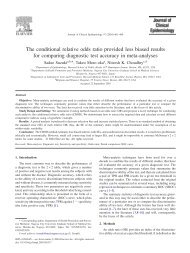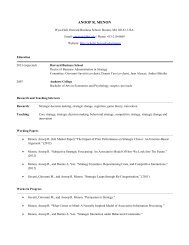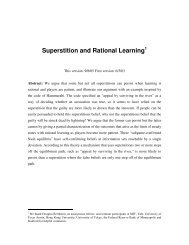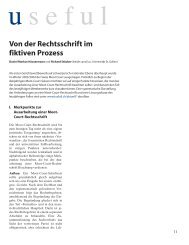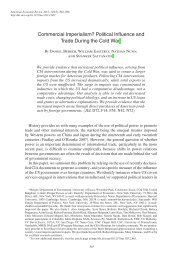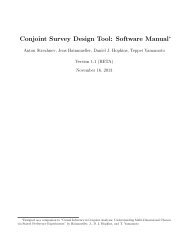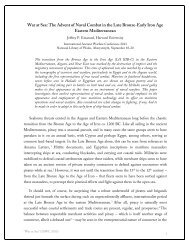Article - Scholars at Harvard - Harvard University
Article - Scholars at Harvard - Harvard University
Article - Scholars at Harvard - Harvard University
Create successful ePaper yourself
Turn your PDF publications into a flip-book with our unique Google optimized e-Paper software.
164 ALBERTO ALESINA ET AL.<br />
models more directly. Thus, our d<strong>at</strong>a allows for a much more serious grounding of<br />
empirical work in theoretical models. For example, in Section 5, we examine measures of<br />
polariz<strong>at</strong>ion, r<strong>at</strong>her than fractionaliz<strong>at</strong>ion, since many models based on con¯ict suggest<br />
th<strong>at</strong> measures of polariz<strong>at</strong>ion are more appropri<strong>at</strong>e to capture the intensity of<br />
disagreements across groups. Another novel fe<strong>at</strong>ure is th<strong>at</strong> our d<strong>at</strong>aset contains group<br />
names, so users can actually identify the groups. For example, Liberia, one of the most<br />
ethnically fractionalized country in our sample, has 13 separ<strong>at</strong>e ethnic groups: the Kpelle<br />
(18.3 percent), Bassa (13.3 percent), Dan (8.3 percent), Grebo (7.5 percent), Kru (7.3<br />
percent), Ma (7.2 percent), Manding/Vai (7.0 percent), Loma (6.0 percent), Americo-<br />
Liberians (5.0 percent), Krahn (4.7 percent), Gola (4.7 percent), Kissi (3.3 percent) and<br />
Gbandi (3.0 percent). In contrast, one of the least fractionalized country in our sample<br />
(South Korea) only displays two groups: Koreans (99.9 percent) and others (0.1 percent).<br />
To give a sense of the possibilities offered by our new d<strong>at</strong>a, Table 4 presents st<strong>at</strong>istics on<br />
the number of available ethnic groups for different geographic areas. 13 Counting entries in<br />
each country, our d<strong>at</strong>aset has a total of 1,054 entries, corresponding to 650 distinct ethnic<br />
groups. The average number of groups per country is highest in Sub-Saharan Africa (7.61<br />
groups per country), and lowest in L<strong>at</strong>in America (4.22). Sub-Saharan Africa only has one<br />
country containing a group th<strong>at</strong> represents more than 90 percent of the total popul<strong>at</strong>ion<br />
(out of 44 countries) while 17 out of 28 industrialized countries (including countries in<br />
Europe, North America, plus Japan, New Zealand, and Australia) display this<br />
Table 4. D<strong>at</strong>a description by ethnic group and by geographical area.<br />
World<br />
West<br />
North<br />
Africa/<br />
Middle East<br />
L<strong>at</strong>in<br />
America/<br />
Caribbean<br />
Asia<br />
Eastern<br />
Europe/Former<br />
Soviet Union<br />
Sub-Saharan<br />
Africa<br />
No. of countries 190 28 19 34 38 27 44<br />
Total (fraction) 0.15 0.10 0.18 0.20 0.14 0.23<br />
No. of groups 1,054 132 83 146 183 175 335<br />
Total (fraction) 0.13 0.08 0.14 0.17 0.17 0.32<br />
Groups/country 5.55 4.71 4.37 4.29 4.82 6.48 7.61<br />
Max. no. of groups 20 9 8 8 20 12 13<br />
Min. no. of groups 1 2 2 2 1 3 2<br />
Avg. pop share of 0.68 0.82 0.69 0.71 0.76 0.72 0.44<br />
largest group<br />
Avg. pop. Share of 0.16 0.09 0.19 0.18 0.14 0.15 0.19<br />
2nd largest<br />
No. of countries 141 25 16 27 34 25 14<br />
with a group 50%<br />
Countries with a 0.13 0.19 0.19 0.18 0.19 0.14 0.04<br />
group 50%<br />
No. countries with a 44 17 4 7 13 2 1<br />
group 90%<br />
Countries with a<br />
group 90%<br />
0.23 0.61 0.21 0.21 0.34 0.07 0.02<br />
Note: West includes Australia, New Zealand and Japan, SSA includes Sudan. This table has the same<br />
structure as Table 1 in Fearon (2002), to facilit<strong>at</strong>e comparisons.




